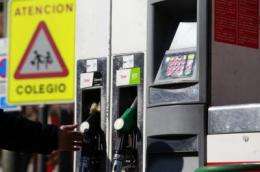Petrol stations pollute their immediate surroundings

In Spain it is relatively common to come across petrol stations surrounded by houses, particularly in urban areas. Researchers from the University of Murcia (UM) have studied the effects of contamination at petrol stations that is potentially harmful to health, which can be noted in buildings less than 100 metres from the service stations.
"Some airborne organic compounds – such as benzene, which increases the risk of cancer – have been recorded at petrol stations at levels above the average levels for urban areas where traffic is the primary source of emission", Marta Doval, co-author of the study and a researcher at the UM, tells SINC.
The study, which has been published in the Journal of Environmental Management, shows that the air at petrol stations and in their immediate surroundings is above all affected by emissions stemming from evaporated vehicle fuels (unburnt fuels from fuel loading and unloading operations, refuelling and liquid spillages).
The research team measured the levels of "typical traffic" pollutants in different parts of the urban area of Murcia, and calculated the quotients for the levels of an aromatic compound (benzene) and a hydrocarbon (n-hexane) at three Murcia petrol stations (near the petrol pumps and surrounding areas) to find the distance at which the service stations stop having an impact.
"In the three cases studied we obtained maximum distances of influence of close to 100 metres, although the average distance over which this contamination has an effect is around 50 metres", Enrique González, the UM researcher who led the research team, tells SINC.
However, the distances depend on the number of petrol pumps, the amount of fuel drawn from them, traffic intensity, the structure of the surroundings, and weather conditions.
According to the researcher, "the more contaminated the zone surrounding the petrol station as a result of other causes (traffic), the lower the impact of the two pollutants at the service station". If traffic in the area surrounding the petrol station is very intense, and exceeds the emissions from the station itself, pollution at the service station is "overlapped and goes unnoticed" over short distances.
Advice for new constructions
The research study shows that a "minimum" distance of 50 metres should be maintained between petrol stations and housing, and 100 metres for "especially vulnerable" facilities such as hospitals, health centres, schools and old people's homes. "Ideally, the 100 metre distance should be respected in plans for building new houses", says Doval.
The researchers propose carrying out this study at new construction areas in which it is planned to build these kinds of facilities. However, petrol stations are not the only source of emission of these pollutants.
"There is not much use in protecting people from petrol stations if the other sources of emission (above all traffic and industries near population hubs) are not controlled or reduced", stresses González.
More information: Morales Terres, Isabel M.; Doval Minarro, Marta; González Ferradas, Enrique; Baeza Caracena, Antonia; Barbera Rico, Jonathan. "Assessing the impact of petrol stations on their immediate surroundings" Journal of Environmental Management 91(12): 2754-2762, december 2010.
Provided by FECYT - Spanish Foundation for Science and Technology

















